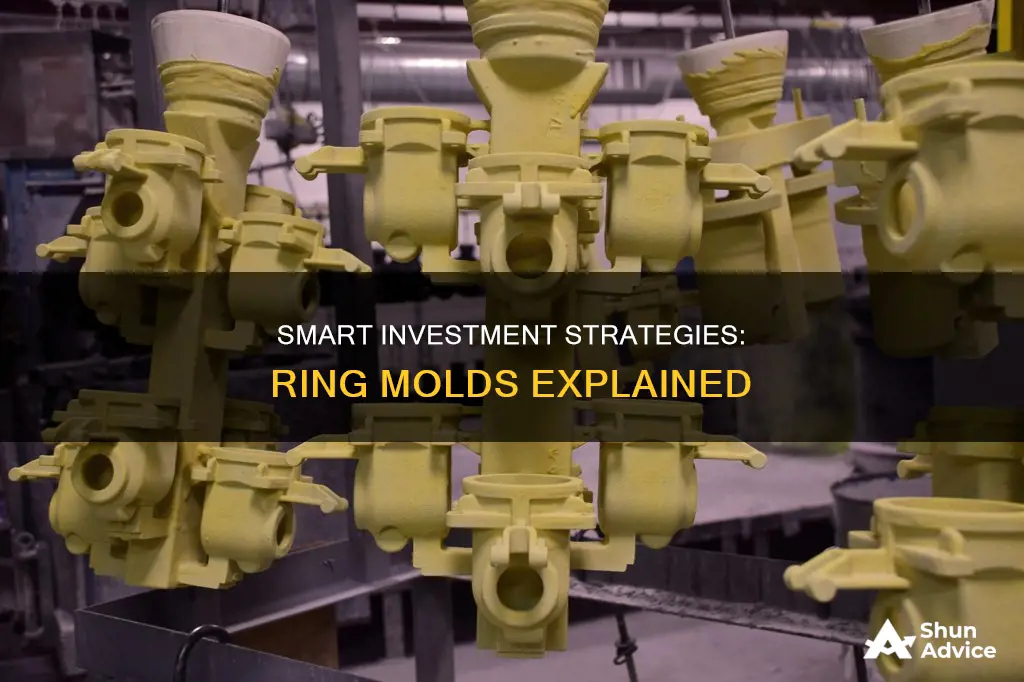
Investment casting is a popular method for creating custom jewellery pieces. It involves pouring liquid metal alloy into a mould. This process is also known as lost-wax casting because the casting mould is created using a wax model that is melted away to leave a hollow chamber in the middle of the mould. The wax model is attached to a rubber base to create a mould. A wax rod called a sprue is connected to the model, which will become the channel through which molten gold or metal alloy flows into the ring. A metal flask is then secured onto the rubber base, and investment plaster is poured into the cylinder and over the wax model. The flask goes into a vacuum chamber to remove any remaining air bubbles, and the plaster is left to harden. The flask is then heated in a kiln to bake the plaster and melt away the wax, leaving a ring-shaped cavity inside. The metal alloy is then melted and poured into the flask using a centrifugal caster. Once the metal has cooled, the flask is submerged in water to dissolve away the investment plaster, leaving behind a solid ring.
| Characteristics | Values |
|---|---|
| Materials | Wax, plaster, metal, gold, silver, graphite, silicone, rubber, crucible, kiln, water, sand, clay, metal flask, vacuum chamber, centrifugal caster, blow-torch, respirator, acid, polishes, enamel, files, hammer, tap, syringe |
| Steps | Carve a piece of hard modelling wax into the desired shape, attach wax wires (sprues), attach the mould to the sprue base, secure the wax model stand to the bottom of a casting flask, mix the dry ingredients of the plaster with water, place the investment mould in a vacuum chamber, pour the investment mould mixture into the flask, allow the investment mould to set, place the flask in a kiln, remove the flask from the kiln, place metal in a pouring crucible, melt the metal, use a jeweller's centrifuge to pour the metal into the mould, allow the metal to cool, dunk it in cold water, tap the mould gently with a hammer, cut away any lines of metal from the sprues, consider an acid bath to clean off any remaining plaster, buff out any irregularities on the jewellery piece |
What You'll Learn

Using a wax model
Wax carving is an ancient technique in jewellery making, dating back 6,000 years. It is a great way to experiment with affordable materials and practice more complex, organic shapes that are challenging to achieve with traditional sheet metal and wire.
To begin, you will need a lump of jeweller's wax. Using a saw and file, carve the wax into your desired shape. You can also purchase wax in different forms, such as wire, tubes, or blocks, that can be bent, twisted, or carved to create your desired shape. For example, if you are making a ring, you can purchase a ring-shaped block of wax and carve it into your desired ring size and design.
Once you have carved your design, you will need to decide which metal you would like to cast it in. You can calculate the weight of your finished metal piece using a wax-to-metal conversion chart. This will help you determine the cost of casting, as casters typically charge a fee for the casting process, plus the cost of the metal by weight.
After your wax model is complete, you can attach it to a rubber base to create a mould. A wax rod, called a sprue, connects the wax model to the rubber base and will become the channel through which molten metal will flow into the ring. A metal flask is then secured onto the rubber base, and investment plaster is slowly poured into the cylinder and over the wax model to avoid causing air bubbles in the plaster. The flask is then placed in a vacuum chamber to remove any remaining air bubbles, and the plaster is left to harden.
After the plaster has hardened, the rubber base is removed, and the flask is heated overnight in an electric kiln. As the temperature rises, the wax melts away, leaving a cavity in the shape of your ring inside the plaster. At this point, you can melt your chosen metal and pour it into the flask using a centrifugal caster. Once the metal has cooled, the plaster mould can be broken open, revealing your finished ring.
Finally, the ring will need to be cleaned, polished, and sized. You can do this yourself or send it to a specialist caster who offers polishing and finishing services.
Millionaires' Secrets: Where They Invest Their Money
You may want to see also

Creating a silicone mould
Step 1: Gather Materials and Prepare the Work Area
You will need the following materials: silicone caulk or construction silicone, liquid soap or cornstarch, water, a bowl, plastic gloves, and an object to create a mould of. It is important to work in a well-ventilated area as construction silicone can produce fumes, and it is recommended to avoid touching it with bare hands as it can irritate the skin.
Step 2: Mix the Silicone with Liquid Soap or Cornstarch
If using liquid soap, fill a bowl with room temperature water and add liquid soap, stirring until it dissolves completely. The ratio should be approximately 1 part soap to 10 parts water. You can also add liquid glycerin at this point, as it will react with the silicone and cause it to clump together.
For the cornstarch method, squeeze construction silicone into a disposable dish and add twice as much cornstarch. You can also add a few drops of acrylic paint for colour if desired.
Step 3: Knead the Mixture
Put on plastic gloves and knead the mixture until it forms a putty. For the liquid soap method, submerge the mixture in the water and knead for about 5 minutes. With the cornstarch method, simply knead until it forms a putty, adding more cornstarch if the mixture is too sticky.
Step 4: Form the Mixture into a Disc
Roll the putty into a ball and then press it against a flat surface to form a thick disc. It should be thicker than the object you will be moulding.
Step 5: Press the Object into the Silicone
Press the object you wish to mould into the silicone, design-side down, ensuring that the back of the object is visible. Gently press the edges of the mould against the object to eliminate any gaps.
Step 6: Let the Silicone Harden
The silicone will need to cure and harden. This process can take about 20 minutes to several hours, depending on the specific silicone used. Refer to the manufacturer's instructions for curing times.
Step 7: Remove the Object from the Mould
Once the silicone has hardened, gently bend the mould back and away from the object to release it. You may need to use your fingers to carefully pry the object out.
Step 8: Use the Mould
Your silicone mould is now ready to use! You can fill it with clay or resin, allowing the material to dry or cure before removing it from the mould.
Buyers' Strategies to Minimize Cash Outlay During Acquisitions
You may want to see also

Using a centrifugal caster
Centrifugal casting is used for small parts of jewellery. To use a centrifugal caster, place the molten bronze in a crucible next to a mould on the arm of the centrifugal-casting machine. The arm spins in a circle, forcing the metal into the details of the mould.
- Prepare the centrifugal-casting machine by placing a crucible containing molten bronze next to a mould on the machine's arm. Ensure that the mould is securely attached to the arm.
- Start the machine. The arm will begin to spin in circles, creating a centrifugal force that will push the molten bronze into the mould.
- Allow the metal to cool and solidify within the mould. The centrifugal force will ensure that the metal fills all the details and crevices of the mould.
- Stop the machine and carefully remove the mould from the arm.
- Separate the mould from the cast piece. This can be done by breaking or cutting the mould away from the metal, revealing the final product.
Centrifugal casting is ideal for creating small, detailed pieces of jewellery, as the centrifugal force ensures that the molten metal fills even the smallest crevices of the mould. This method can be used with various metals, including bronze, to create intricate designs.
Is Your Cash App Investing Insured? Know the Facts
You may want to see also

Finishing your jewellery
Now that you have cast your ring, it's time to finish it. The first step is to cut away any lines of metal from the sprues using an angle grinder with a cut-off wheel. You will need to cut away the thin pieces of metal that you needed to create a hole to pour the metal in.
Next, you may want to consider an acid bath or wash to clean off any remaining plaster. This step will leave your metal looking much cleaner and shinier, and will make the job of polishing it later much easier.
Finally, use files, enamel clothes, polishes, etc. to buff out any irregularities on the ring and clean it up to your desired style. If you are planning on setting a stone, you should do this after you have finished polishing the ring.
Strategies for Investing Cash Without IRS Attention
You may want to see also

Lost-wax casting
Step 1: Cast the Wax
Gather some wax, such as old broken crayons, and melt it in a pot or cut-down soup can over a stove. Remove any paper wrappers from the crayons before melting. Once melted, pour the wax into a mould, such as a small popcorn tin lid, to create a wax disk that can be easily removed and carved.
Step 2: Carve It Up!
Before carving, draw a template on paper. If your design includes swirls, use a compass to get smooth curves. You can also trace a normal wedding ring to get an idea of the ring size. Once you have your drawing, place the paper on the wax disk and trace the lines with a carving knife. Now, begin carving the ring, being as creative and detailed as you like. If you break the wax, you can solder it back together with a heated metal tool.
Step 3: Prepare for the Plaster
Take a short crayon and solder it to a blank area of the ring band. This will create a hole for pouring metal into the ring cavity. Melt some crayon onto the bottom of a paper cup and stick the crayon shaft onto it to create a pedestal for the ring to stand on.
Step 4: Plaster Goop
Mix a batch of plaster, such as plaster of Paris, and vibrate it to remove air bubbles. Pour the plaster into the cup and tap it to bring any remaining bubbles to the surface. Let the plaster set and dry for about two weeks.
Step 5: Fire the Mold
Using a furnace, heat the mold for about 30 minutes to melt out the wax. You can use a paint can with a hole cut in the side, with charcoal lit and placed inside, as a simple furnace. Place the mold on a bed of gravel or sand after heating.
Step 6: Cast the Ring!
Melt your chosen metal in a furnace and pour it into the hole in your mold. You can use a cut-down soup can or a crucible for melting the metal. Be cautious as the metal may react with the plaster or residual wax and create gas bubbles. Allow at least 30 minutes for the metal to cool.
Step 7: Remove the Ring
Break open the mold using a hammer to reveal your cast ring.
Step 8: Finishing
Use a hacksaw to cut off any excess metal attached to the ring band. File and polish the ring to your desired finish. You can use a Dremel tool, cutting bit, or large wood files for initial shaping, and then sandpaper to smooth and shine the ring.
Safety Precautions:
- Wear protective clothing, including leather gloves, natural fibre clothing, long pants, and sleeves.
- Use insulated gloves and safety goggles when working with molten metal.
- Work in a well-ventilated area to avoid dangerous fumes.
- Keep a chemical fire extinguisher nearby.
- Ensure your walkway between the furnace and the mold is clear.
- When working with dry materials, ensure your work area is well-ventilated and wear a respirator.
Smart Ways to Invest $10,000 for Maximum Returns
You may want to see also
Frequently asked questions
Lost-wax casting is a process where a wax model is created and then covered in plaster. The plaster is then heated to melt away the wax, leaving a cavity in the shape of the wax model. Molten metal is then poured into the cavity, creating a metal version of the original wax model.
You will need wax, a melting pot, a stove, pliers, a mold, plaster, a kiln or furnace, and metal.
You can use gold, silver, or an alloy such as zinc, lead, or tin.
First, carve your desired shape out of wax. Attach "sprues," or wax wires, to the model to provide a channel for the wax to melt out. Attach the mold to a sprue base and secure it to the bottom of a casting flask. Mix the investment mold material with water and place it in a vacuum chamber to remove air bubbles. Pour the mixture into the flask, surrounding the wax model. Allow the mold to set and then place it in a kiln to harden and melt the wax. Remove the flask from the kiln and pour your molten metal into the cavity. Allow the metal to cool, then dunk it in cold water to dissolve the plaster. Tap the mold gently with a hammer to break away any excess plaster and reveal your ring.







